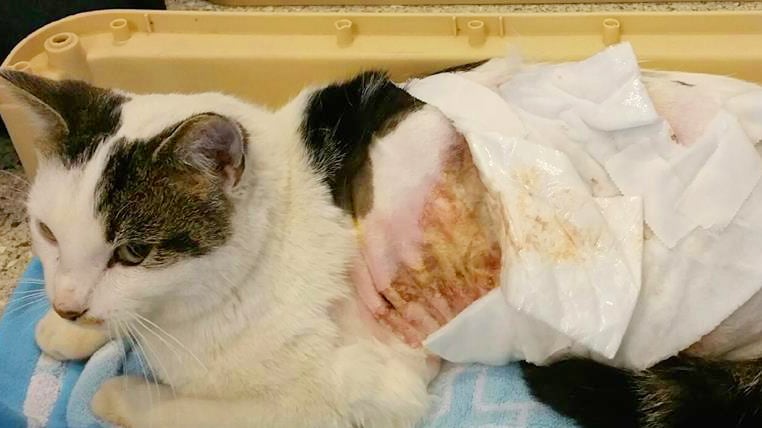On Feb. 2, an 18-year-old from Chicago’s south side Grand Crossing neighborhood posted a video to his Facebook page depicting himself boiling a pan of water, coaxing a stray cat to his front door, then throwing the hot water on it, severely scalding the cat. The yowl of terror and pain the feline let out is blood curdling.
The perpetrator, Leon Teague, posted his video to his Facebook page under the pseudonym Glock Boy MurDoc. In posting the footage, he opened his act of animal abuse to public scrutiny. As is common to controversial social media content, reactions were vastly divided. Some liked the post and wrote joking comments, while others were horrified, irate, and disgusted.
Bringing an act of animal torture into the spotlight via social media incites a host of problems and questions. What is so special about this particular case on feline abuse, when it happens daily without broadcast? Why does public dialog quickly devolve into negative assumptions, threats of violence, and racial slurs? Why is there no conscious awareness of right and wrong with these perpetrators, allowing them to not only commit calculated acts of abuse but also brag about it? Are those who are outraged overreacting to an animal many consider a nuisance? Why should we even care about a homeless, stray animal? Does rebuttal or expressing disgust on social media really make a difference?
The upside of posting heinous criminal activity on Facebook is it allows viewers to anonymously report a criminal activity that goes largely unreported. The official police report (PDF) states upon visiting Teague’s home, officers recognized the apartment’s interior and his voice from the video, thus arresting him. Awaiting arraignment today, if Teague is found guilty, he will have to serve one year mandatory up to five years in prison for a felony count of animal torture, and one misdemeanor count of cruelty depiction, as well as a fine up to $25,000.
But what makes this case any different than the thousands of other animal cruelty cases Chicago handles each year? If a tree falls in the forest and nobody hears it, does it make a sound? If a cat is tortured by someone lacking empathy and there’s no video or witness to prove it, does anyone care?
According to the ASPCA, there are an estimated 70 million stray, feral, and colony cats in the U.S. While cats are considered beloved pets by 35 percent of American households, that leaves 65 percent indifferent about them or consider cats “useless,” explains Tree House Humane Society Director Jenny Schlueter. In speaking with The Daily Beast, she also explained many actually consider them a nuisance more along the lines of a city rat rather than our utilitarian canine companions. There are even veterinarians sworn to protect animals who brag about their murderous contempt for cats.

Cat torture, abuse, and neglect happens daily, not only in Chicago, but in every metropolitan area and small town alike. As Chicago Police Lt. John Garrido related to The Daily Beast, unreported criminal activity is one of the biggest obstacles to investigating and prosecuting cat cruelty cases. Where lack of empathy is not an issue, witnesses in high-crime neighborhoods are hesitant to call 911. CPD has a less than sterling rapport with its minority populations (look to the Laquan McDonald situation as an example of turbulent police-community relations), and residents do not want to cause waves by summoning the police to their block. Others are weary of retaliation for “snitching,” so they turn a blind eye. And when citizens do call the police to report animal-related crime, it is more typically dog fighting, which hosts a myriad of other seedy activities: drugs, guns, gambling, and mass assembly of questionable types that affect people’s well-being, not because kittens are used as fight bait. As Garrido notes, police can only be as effective as the witnesses willing to come forward and report criminal activity.
“We take animal abuse reports very seriously. But we rely on community advocacy to help our efforts.”
There are over 70,000 calls to animal control annually in Chicago. But there are only four officers dedicated to investigating animal-cruelty cases. Garrido points out that Illinois has the the toughest laws on animal abuse (PDF). But even when a cat-abuse crime is reported and a criminal identified, a case cannot be prosecuted without a willing witness and undeniable proof. With injured cats fleeing the scene of their trauma, there is literally no body of evidence, and thus no case. He is hopeful the stiffer penalties and the FBI’s new policy of adding felony-animal convictions to the National Incident-Based Reporting System will deter future acts of violent against animals. But, the new FBI data collecting is simply a method of profiling convicts, not a system of punishment. It will be several years before we know its effectiveness.
Social media also play a crucial role in bringing awareness to cat cruelty, and helps constantly financially strapped no-kill rescue raise funds to further their rescue, rehabilitation, and education efforts. Chicago’s Felines and Canines has been posting updates on the abused cat they are now caring for and have named Driver. Executive Director Abby Smith notes that rescue sadly must rely on the publicity of these cases to engage the public and relieve Driver’s medical care costs—which are in the high thousands with IV medications, pain management, and laser treatments at a veterinarian hospital. Posting status updates keeps concerned followers engaged not only to this case, but the need for support to cure and prevent other cat abuses.

It was also due to backlash of Teague’s arrest and his friends posting public threats to other neighborhood cats until Teague is released, that rescue Tree House Humane Society sprung into action to find, trap, spay, foster, and relocate as many other cats in the Grand Crossings area as possible. So far, they’ve found 19 felines with various signs and scars of abuse and illness, and they’re receiving daily calls from area residents who are now aware of their presence and rescue efforts. Not only has Facebook given offenders a platform to taunt animal lovers, it also provides a safe, anonymous vehicle to ask for help without police involvement.
The anonymity of social media also empowers cyberbullies and trolls to destroy unity and compassion for animal abuse and rescue. For every person sharing a story of sympathy or sadness, there are twice as many posting videos of puppy tossing and cat torture as entertainment. Commentary also quickly devolves from civil to hateful and even racist, having nothing to do with the victim at hand, further diminishing the efforts of rescue and prevention. Commenters on NBC 5 Chicago’s Facebook page called Teague an “ape” and suggested he be boiled and jailed with white supremacists. Some in Teague’s community ask, “Who cares about this stupid cat when people are being shot in our neighborhood every day?” spinning an animal-abuse case into a social injustice battle cry.

Tree House’s Schlueter was quick to point out the negativity and mythology of cats is not tied to any one ethnic group or socio-economic demographic. There are an equal number of cat lovers and cat haters in any given Chicago neighborhood. She says the main difference may only be the type of cat abuse that happens—it could be violent activity in the under-served communities, feeding strays rat poison in upper-class neighborhoods, or severe hoarding and neglect in a middle-class home. Neither of the incendiary takes documented on Facebook have anything to do with the case at hand, nor bring awareness or solutions to handling the citiy’s stray cat issues.
So we’re still at the point of asking “Why should we care about abuse that happens to a feral, ownerless cat? Why are we investing in pesky critters when there are human crimes to address?” Here’s why.
Numerous studies cite animal abuse as the beginning of most violent offenders’ criminal legacy—particularly rapists, serial killers, and domestic abusers. With the toughest and most detailed animal-abuse laws of all 50 states (PDF), Illinois’ felony animal-abuse conviction requires a mandatory psychological evaluation and subsequent treatment. This offers a way to redirect felons and possibly address underlying sociopathic issues, preventing future abuse—to animals and humans.
Working with verified nonprofit, no-kill rescues builds community togetherness, trust, and safety for witnesses of animal crimes and the victims. If the rescue has a TNR program, they may not eradicate all of the strays now, but spay/neuter does have a high success rate over time in lowering stray populations and kill rates in open access shelters. In 1997, Chicago was cited as having the worst animal control kill rate, with 93 percent of its 28,000 animals euthanized. Through the tireless efforts of dozens of no-kill rescues and successful programs like Tree House’s Community Cats TNR and PAWS Chicago Community Outreach, there were 17,000 animals admitted to the city shelter, with only 27 percent never making it out. In 10 years, stray numbers were reduced by 10,000.
Social media’s effect on efforts to further prevent cat abuse will never fade. But what if more people angered by these heinous acts volunteered more and spewed less bile online? What if more compassionate people reached out to under-served communities to educate people who’ve never been presented the basic idea of animal kindness nor offered non-violent solutions to their concerns? Not everyone has to start adoring cats, but they can at least build an understanding of respect for other living beings if encouraged. And we can stop using media as a tool for hatred and mistrust. Schlueter is hopeful the attention this scalded cat case has generated can be turned into an opportunity for dialog about animal compassion and more confident community building across the divide.





